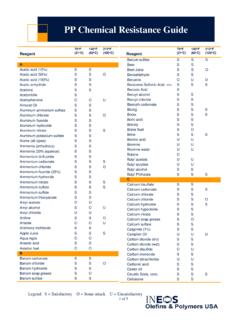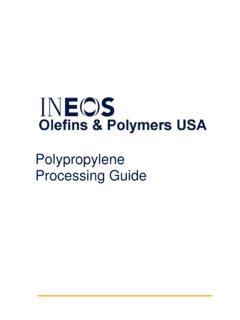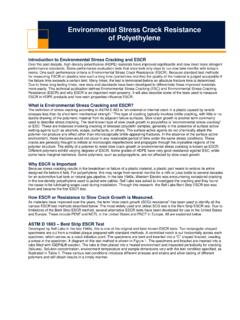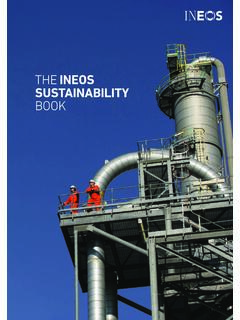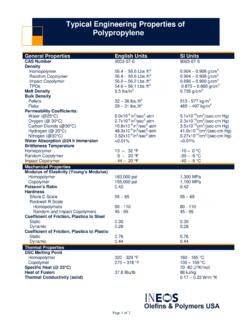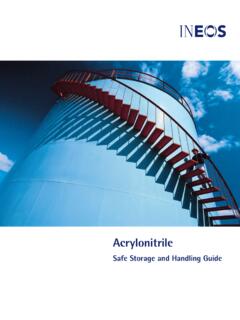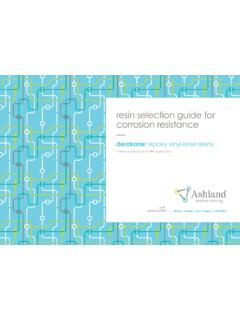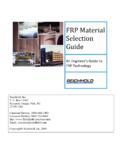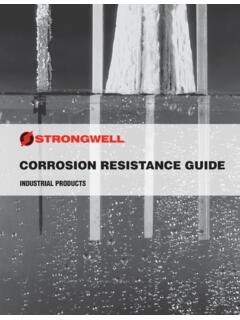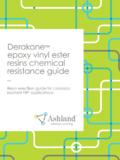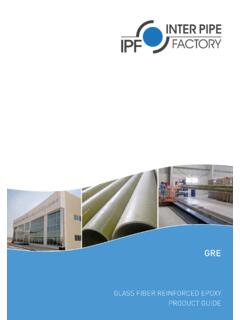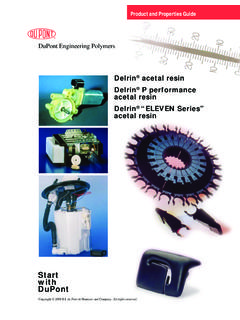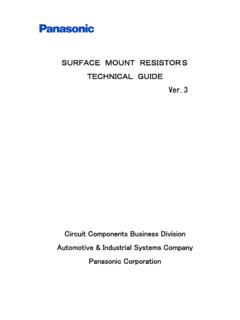Transcription of DERAKANE FABRICATION GUIDE - Ineos
1 DERAKANE FABRICATION GUIDE .. A GUIDE TO FABRICATING FRP COMPOSITES. DERAKANE EPOXY VINYL ESTER RESINS.. Ineos Composites DERAKANE epoxy vinyl ester resins provide excellent chemical and corrosion resistance coupled with outstanding heat performance and toughness qualities that have made them the materials of choice for a wide range of fiber-reinforced plastic (FRP) applications. DERAKANE resins can be used with conventional fabricating techniques to produce durable and dependable structures that require little maintenance over a long service life. This GUIDE serves as an introduction to working with DERAKANE resins and selecting the most appropriate additives for room-temperature contact-molding-type applications. We developed this GUIDE to help fabricators choose the most effective combinations of DERAKANE resins and reinforcements to produce corrosion-resistant composites for a variety of end use applications. The FRP industry has a wide range of needs; IMPORTANT: The information contained in this GUIDE and the various products described are intended for use only by persons therefore, the information that follows is general having technical skill and at their own discretion and risk after and intended to serve as a basic GUIDE to working they have performed necessary technical investigations, tests and evaluations of the products and their uses.
2 Certain end with these products. Advice on the selection of uses of these products may be regulated pursuant to rules or resins for specific corrosive services is beyond regulations governing medical devices, drug uses, or food or the scope of this GUIDE . For additional guidance, food contact uses. It is the end user's responsibility to determine the applicability of such regulations to its products. we recommend the Resin selection GUIDE for All statements, information, and data presented herein are Chemical resistance , DERAKANE Epoxy Vinyl believed to be accurate and reliable, but are not to be taken as Ester Resins. Specific material selection guidance a guarantee of fitness for a particular purpose, or representation, express or implied, for which Ineos Composites assumes legal and recommendations are available by contacting responsibility. No freedom to use any patent owned by Ineos . DERAKANE Technical Service at Composites, its subsidiaries, or its suppliers is to be inferred.
3 For more information about DERAKANE , DERAKANE . Registered trademark, Ineos Composites or its subsidiaries, registered in various countries Momentum , and DERAKANE Signia resins, please . Trademark, Ineos Composites or its subsidiaries, registered in various countries contact your Ineos Composites sales representative 2019 Ineos Composites or distributor, visit , or email us at We want to be your resource of choice and encourage you to reach out with questions or comments. 2. CONTENTS Section 7. Joining and Repair Section 1 Thermoset 1. Equipment 2. General Section 2 3. Surface Reactive 4. Resin Initiators1 ..5 5. Resin Promoters1 ..7 6. Joining Pipe or Section 8. Gel Time Retarder for DERAKANE Inspecting a Visual Section 3 Barcol Non-Reactive Acetone Antimony Section 9. FABRICATION Mold Release FABRICATION Ultraviolet (UV) FABRICATION Wax Section 10. Surfactants and Antifoam Health, Safety and Regulatory Abrasion-Resistant Safety Data Sheets (SDS)..57. Section 4 Section 11.
4 Resin Standard Reinforcement Sequence for Storage Corrosion-Resistant Resin Types of Inventory Storage of Glass Aerating the Section 5 Bulk Resin Appendix A. Adjusting Promoter/Initiator Levels for Practical Trade Names and Material Factors Affecting Resin Working Appendix B. Measuring Small Quantities of Equipment Preparing a Master Batch of Appendix C. Section 6. Food Contact and FDA/USDA Making a Test Laminate and Applying FRP Food Making a Test Fabricating for FDA/USDA GUIDE to Making a Post Curing the Appendix D. GUIDE to Making a Conductive Troubleshooting GUIDE ..66. Secondary Troubleshooting GUIDE for Curing DERAKANE . Applying a Test Resins at Room Making a Laminate Troubleshooting GUIDE for Curing Lining a Metal Surface ..30 DERAKANE Signia and DERAKANE Momentum . Resins at Room Lining an FRP Lining a Concrete Epoxy Vinyl Ester Resin Anchors for 3. SECTION 1. Thermoset Resins thinner film-coating applications, steps must be taken DERAKANE resins are thermosetting resins.
5 They to add strength to epoxy vinyl ester resins. cure by crosslinking between reactive polymers and Typically, reinforcement is accomplished by adding a reactive diluent, typically styrene. This crosslinking glass fibers to the resin before curing. The glass fibers is accomplished via a free radical polymerization strengthen the cured resin, but do not chemically reaction that is initiated by the addition of ingredients react with it. The resin/glass fiber combination creates that readily form free radicals. Formation can be a very strong, corrosion and heat-resistant material started with heat or by using additives that work referred to as FRP. at ambient temperatures. For consistently high-quality end products, all of the DERAKANE resins begin as a viscous liquid. Once materials used in FABRICATION must be selected with reactive additives are added, the liquid cures care, precisely formulated, and used by well-trained irreversibly into a solid polymer network.
6 Cured resins workers who are familiar with the special techniques are inherently heat and corrosion-resistant. However, required when working with FRP. without suitable reinforcement, they may not be strong enough for many applications. Outside of SECTION 2. Reactive Additives technical data sheet (TDS). Review the associated Materials that initiate free radical formation (initiators), safety data sheet (SDS) for these additives prior to cause free radical formation at room temperature using them. (promoters) and adjust resin reactivity (accelerators, Appendix A and B include lists of suppliers for many inhibitors and retarders) are listed in Table of the products described in this section. They are Recommended initiator, promoter and inhibitor levels not the only suppliers of these products; check with for specific resins can be found on their respective a local distributor for availability in your area. Initiators Promoters Accelerators Inhibitors Retarders Methyl ethyl Cobalt naphthenate Tertiary butyl 2,4-Pentanedione ketone peroxide Dimethylaniline (DMA).
7 (6%, 12%) (CoNap) catechol (TBC) (2,4-P). (MEKP). Benzyl peroxide Cobalt octoate Toluhydroquinone Diethylaniline (DEA). (BPO) (CoOct) (THQ). Cumene Dimethylacetoacetamide hydroperoxide Hydroquinone (HQ). (DMAA). (CuHP). Diethylacetoacetamide (DEAA). Table : Common initiators, promoters, accelerators, inhibitors and retarders. 4. Initiators1 CoNap/CoOct 6% is suggested for DERAKANE . Initiators, sometimes erroneously referred to as Signia resins. Elevated ambient humidity may require catalysts, are organic peroxides that work with higher levels of CoNap/CoOct 6%. promoters to initiate the chemical reaction that Note: The promoters CoNap/CoOct 6% should never causes a resin to gel. The amount of time from when be mixed directly with a peroxide initiator such as the initiator is added until the resin begins to gel is MEKP. Direct mixing will result in a violent reaction, referred to as the gel time. Initiator and promoter and possibly a fire or explosion. levels can be adjusted to shorten or lengthen the gel MEKP.
8 Time somewhat and accommodate both high and low temperatures. Figure shows how a resin system's MEKP, commonly supplied at 9% active oxygen, is gel time shortens as the temperature increases. the most widely used initiator system. MEKP is used with promoters, usually 6% CoNap or 6% or 12%. CoOct, and accelerators including dimethylaniline (DMA), diethylaniline (DEA), dimethylacetoacetamide 100. (DMAA), or diethylacetoacetamide (DEAA). MEKP will 90. 80. not cure when used only with DMA, DEA, DMAA, or 70 DEAA; a cobalt promoter must be used. Gel Time (minutes). 60. 50. Typically, MEKP initiators are blends of MEKP. 40 isomers. MEKP performance varies by brand;. 30 common differences include variations in gel time, 20 exotherm temperature, and cure time. In addition 10. to variations due to isomer proportions, significant 0. 15 25 30 variations can arise based on resin. Temperature ( C). An MEKP brand that works well with one resin may not work well with another. Different results are due Figure : Gel time versus temperature.
9 Primarily to the varying monomer and dimer contents of various peroxides. The following initiator brands have a high dimer content and have shown consistent Two primary types of initiators are recommended for reactivity and excellent resin cure development when curing DERAKANE resins at room temperature: methyl used with DERAKANE resins: ethyl ketone peroxide (MEKP) and benzoyl peroxide (BPO). A third, less-common initiator, cumene Luperox 2 DHD-9. hydroperoxide (CuHP), is often blended with MEKP Norox 3 MEKP 925 H. and used to lower the exotherm (heat buildup) and Butanox 4 LPT-IN. extend the gel time of DERAKANE resins. CuHP with cobalt naphthenate/cobalt octoate (CoNap/CoOct Other brands may work as well, but should be 6%) can also be used with rapid cure resins, such thoroughly evaluated before use. For optimum results as those in the DERAKANE 470 series, to reduce the with standard DERAKANE resins, it is important exotherm temperature. to maintain the recommended ratio of MEKP to CoNap/CoOct 6% in the cure system.
10 A minimum Fabricators can achieve a range of working times by ratio of 3:1 (MEKP: CoNap/CoOct 6%) is required. varying the amount of initiator they use with a resin. A maximum ratio of 10:1 has also proven satisfactory. However, they must do so with care. If the initiator Using proportions outside of a 3:1 to 10:1 range may level is too low, an incomplete cure may occur, which produce a poorly cured laminate with low Barcol can result in degraded physical properties and hardness and inadequate corrosion resistance . reduced chemical resistance . On the other hand, The ratios can be made less critical by using DMA. if the initiator level is too high, laminates, and thick or DMAA as an accelerator. laminates in particular, can delaminate, burn, or discolor during curing. Excessive initiator levels may also result in reduced chemical resistance . Choosing the proper initiator is critical to achieving the expected chemical resistance , and care must be taken not to select initiators that cure too fast or too slow.

